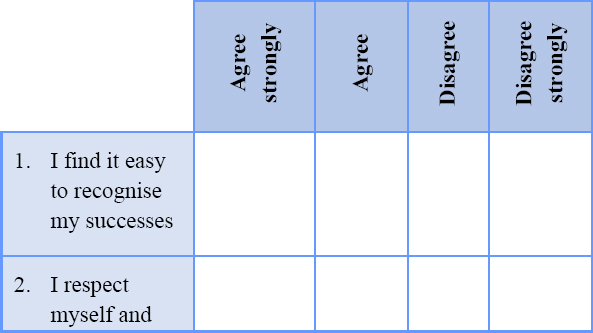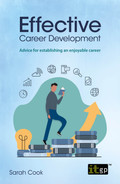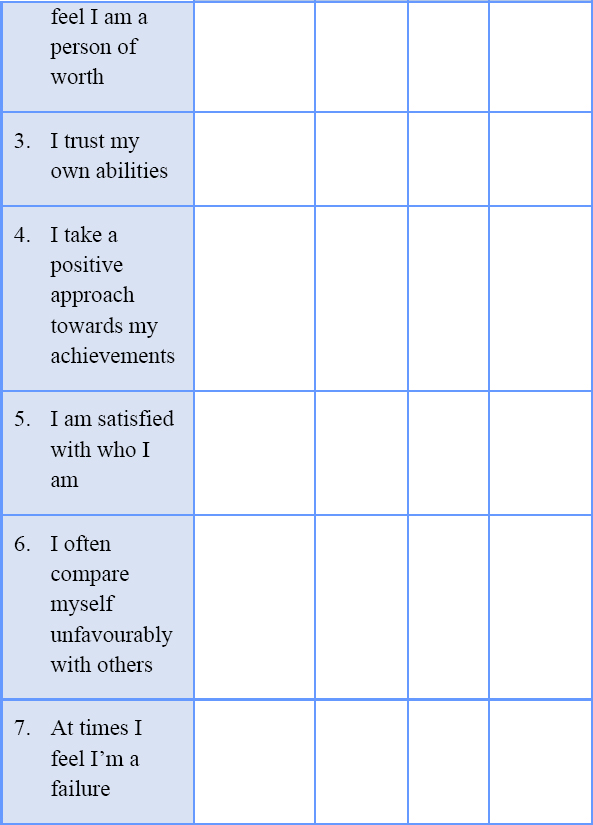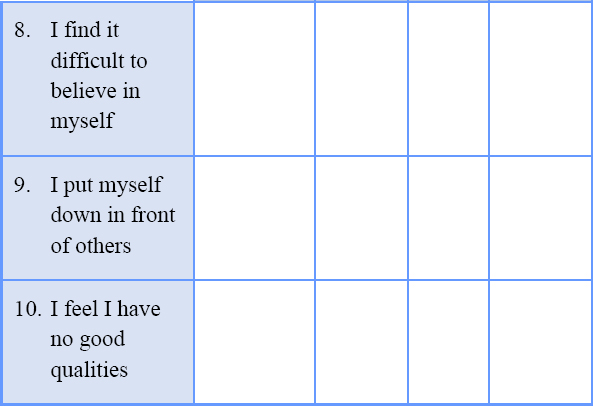CHAPTER 7: PROMOTING YOURSELF
Throughout this book I’ve encouraged you to take personal responsibility for your career. In this chapter, we’ll look at what you can do to promote yourself so that you achieve your career goals. I’ll discuss what can stop you getting what you want, how to build your self-confidence and develop your personal brand as well as using tools such as LinkedIn to promote yourself as well as tips for preparing a ‘stand-out’ CV.
Self-confidence assessment
To develop your career, you need to believe in yourself, recognise your successes and trust your abilities.
Use the following assessment to evaluate your levels of self-confidence.
Table 3: Self-confidence Assessment

How to score
For statements 1 to 5, score:
• 4 points – Agree strongly
• 3 points – Agree
• 2 points – Disagree
• 1 point – Disagree strongly
For statements 6 to 10, score:
• 4 points – Disagree strongly
• 3 points – Disagree
• 2 points – Agree
Now total your score.
Scores between 31 and 40: You have a great deal of confidence in yourself. This will help you to promote your successes and drive your career forward.
Scores between 21 and 30: You have medium levels of self-confidence. Look at which your low-scoring areas and consider how this impacts your approach to career development. Read the following pages for tips and advice on improving your self-confidence.
Scores between 10 and 20: You have low levels of self-confidence. Your ability to progress in your career may be hampered by your own limiting self-beliefs. Read the following pages for tips and advice on how to build your confidence.
Barriers to career development
There are things in life we have little influence over, such as world events and the economy. However, in our immediate sphere of influence, we all have the capacity to achieve most of our goals, given the right skills and qualifications.
Often the biggest barriers to us achieving our career goals are the beliefs we hold about ourselves. One of the reasons we suffer from lack of confidence is because we allow too many negative thoughts, which can create feelings of failure and rejection. Our beliefs can block and limit our progress and make us fearful of change.
Typical limiting beliefs around careers include:
• ‘It’s safer to stick to what you know’
• ‘I’m not capable of change’
• ‘It’s too difficult for me to learn new skills’
• ‘I can’t move because of my family circumstances’
• ‘The right job will come along in the end’
• ‘I’m not a credible candidate’
• ‘My experience is too limited’
Consider your own limiting beliefs. Now challenge yourself as to whether these are true, and consider how you can begin to overcome these barriers. Read on for tips and advice.
Career development approaches
When it comes to developing your career, there are four approaches you can take: :
1. Accept and make the most of the situation
For some people, accepting and making the most of your current work situation is a suitable career strategy. It’s about appreciating what you already have, enhancing the positives and minimising the negatives. It could be, for example, that you decide to stay where you are and focus more on other aspects of your life, spend more time with your family and develop more outside interests.
2. Change the current work situation
If you feel stuck in your career, the answer is not always to quit your job. It’s easy to blame others and wait for them to notice and give you what you need.
Consider what’s hindering you at work. What can you do to change the situation? This could involve taking on a new project, asking for a pay rise, influencing your boss or changing your working practices to give your role a reboot.
3. Change yourself
Consider how you can change yourself to make things better. For example, you could learn new skills, alter your behaviour, adjust your expectations or change your lifestyle so that you feel more fulfilled.
4. Leave
The last option involves moving on from your current situation. This could be getting a new role, changing industries or taking time off.
Whatever option you choose, you’ll need to have confidence and self-belief to act.
Developing self-confidence
Here are some simple exercises to help build self-confidence.
Practical activities for increasing your self-confidence
1. Write a positive letter of affirmation
• Write a list of statements about yourself that you know are true – you need at least six statements.
• Write them in the present tense using positive language.
For example:
1. “I am a systematic and logical thinker”
2. “I am a confident speaker”
3. “I am a great problem-solver”
Keep this list of positive affirmations with you at work and read them twice a day until you memorise them. Repeat the phrases to yourself during any stressful situation to alleviate your anxiety.
2. Avoid comparing yourself to others
People with low self-confidence tend to compare themselves to others and consider themselves less able or less experienced. They may have self-doubt and feel they are not worthy of their position, that soon they will be ‘found out’. Sometimes called ‘imposter syndrome’, this can put an individual’s happiness and well-being at risk.
To avoid this, reframe how you think about others. If you see someone who is good, for example, at speaking up in meetings, think ‘what can I learn from this person?’, rather than ‘I’ll never be good at that’.
Focus on the things that are going well in your life and that you are grateful for. I find writing a ‘gratitude list’ very helpful in this respect. Each day, write down one or two things that you appreciate. This can be anything that resonates with you, e.g. ‘The view of the sunrise from my window this morning’ or ‘My sister sending me a WhatsApp message to see how I am’. When you find your own contentment, you are less likely to compare yourself to others.
If you lack self-confidence, you’ll often find it hard to recognise your strengths and talk about your needs. This will probably be as much the case at home and with friends as with colleagues and your manager at work.
A safe place to begin building your confidence is by talking about your achievements with friends and family. Speak about small successes and things you are proud of; it doesn’t have to be work related, e.g. a nice meal you cooked or a walk you took with friends. The important thing is finding your voice and feeling comfortable about articulating your contribution to something. The more you practice this at home, the easier it will become to speak up about your strengths in a work environment.
4. Visualise yourself being successful
The ability to see yourself doing things well acts as a program for the mind to put those steps into action – the unconscious mind cannot differentiate between fact and fiction!9
To visualise success, think of an occasion or situation where you do not feel confident, e.g. presenting in front of a certain group of people.
Close your eyes and imagine yourself being successful. Watch yourself doing what you want to happen.
• Where you are;
• Who is with you;
• What you are saying and doing;
• How you look – how you are dressed and the gestures you use; and
• The positive reactions from others to what you are saying and doing.
Play this over several times in your mind, making the picture clearer and clearer each time. Notice the physiological changes as you do and how much more positive you feel about the event.
Do this before any situation where you need to be confident.
5. Positive self-talk
This activity will help you become more aware of your emotions and self-talk, using two contrasting situations: one where you are confident and the other where you lack confidence. This will highlight the need for positive self-talk to be confident.
First, think of a recent occasion where you felt confident. Answer the following questions:
• What was happening?
• What were you saying to yourself about the situation (your self-talk)? What tone did your self-talk have? What kind of language were you using?
• What physical sensations and feelings were you aware of?
• What was the outcome of the situation?
Next, think of a recent occasion where you did not feel confident. Answer the following questions:
• What was happening?
• What were you saying to yourself about the situation (your self-talk)? What tone did your self-talk have? What kind of language were you using?
• What physical sensations and feelings were you aware of?
• What was the outcome of the situation?
Compare your reactions to the two situations. Think about the actions you can take the next time you lack confidence and answer the following questions:
1. What positive statement could I say to myself to be reminded of my strengths and achievements?
2. What could I do that would help me feel differently?
3. What could I do differently next time I am in this situation?
4. What self-talk or actions would empower me?
Building your personal brand
According to a 2020 study, almost all employers (98%) do background research on candidates online. Most HR professionals (72%) say a résumé is very important when evaluating an applicant. Almost all employers (95%) consider an “elevator pitch” important.10
To stand out from the crowd, therefore, candidates need a tailored, professional online and offline presence. This means creating a ‘personal brand’, a unique identity that shows your value to potential employers. Like a commercial brand, a personal brand sets out who you are, the values you embrace and the way you express those values.
To create your own personal brand, here are some questions to ask yourself:
• What do you want to be known for? I.e. what do you want people to say about you when you are not in the room?
• What do you stand for?
• What motivates you?
• What situations energise you?
• What characteristics are you most complimented on?
• How can you reinforce your personal brand?
In answering these questions, and considering who your audience is, you can create an ‘elevator pitch’ about yourself.
Creating an elevator pitch
Most employers consider an “elevator pitch” important.
Sometimes called a ‘personal statement’, this is a short summary of your personal brand that is condensed enough to fit into the length of an elevator (lift) ride – a 30 to 60 second statement about who you are. Effectively, it is a reduction of the essential components of your brand – who you are, what you stand for and what you can offer.
If you have not done so already, I strongly recommend developing an elevator pitch.
You can use your personal brand to promote yourself via LinkedIn, CVs and interviews. Your elevator pitch or personal statement will also help you in these situations.
Using LinkedIn
According to a 2020 study by The Manifest, a business news and how-to website, most employers (90%) factor a job candidate’s social media accounts into their hiring decisions, and79% have rejected a candidate based on their social media content.11
LinkedIn is the most used global recruitment tool. The platform now boasts more than 830 million members in more than 200 countries.12
It is important that you think strategically about how you want people to perceive you and your personal branding online. Most people have a LinkedIn profile, but many people don’t complete all the sections. It is important to do this as it gets you more attention.
Here are some key tips to best optimise your LinkedIn profile:
• Look at the profiles of people you know and compare with your own.
• Search for your name on LinkedIn – is it easy to find? You can edit your profile URL so that it contains just your first name and surname rather than numbers. If your name is difficult to pronounce, make use of the name pronunciation feature on LinkedIn, which allows you to record how to pronounce it. You can also use this feature to record a personal message about yourself.
• Use a high-quality professional photo for your profile picture. To ensure search engines can find your profile, click on your photo and choose the option of showing the photo either to ‘All LinkedIn Members’ or ‘Public’.
• Use the profile headline and the ‘About’ section to fully describe your expertise, who you are, where you add value, what you stand for. This is the ‘landing’ section for your audience, so use interesting and descriptive language to attract the visitor and showcase your personal brand.
• Fill in your work history and education. Remember to highlight key projects and achievements. If you’ve had a long career, it’s best to only list the most recent 10 to 15 years.
• Fill in the skills section. It’s helpful to have endorsements from other people, and for you to endorse others. This is because when you endorse someone on LinkedIn, the endorsement goes both on your and their profile. Recruiters search for people who are endorsed by others. They also search by industry groups, so it is useful if you belong to relevant groups.
• Post online, comment on others’ posts and add links to your profile – the more activity you have, the higher your social networking score.
Creating an impactful CV
The 2018 Recruiter Study also found that nearly three out of four recruiters (72%) say a good CV is very important when evaluating an applicant.
Each job post can receive up to 250 applications. The principal way that recruiters sort through CVs is via an applicant tracking system (ATS). This software scans applications to find key words linked to the job description.
A tip is to identify the key words in the description of the position you are applying for. Incorporate these in the descriptions of your own achievements and experience on your CV, including in your personal statement. Matching as many keywords as you can will help recruiters locate your profile. This means you need to ‘tweak’ your CV and cover letter to each potential job application.
Here are some when tips when preparing your CV:
Dos and don’ts in presenting yourself at interview or assessment centres
If you are called for interview, ensure that you research the company beforehand.
Know your CV well and prepare examples of your achievements relating to the job and desired behaviours. Think SARR: situation, action you took, results and relevance (to the role).
If, as sometimes happens, you are asked to deliver a presentation on a topic, make sure that you rehearse this beforehand and that you stick to time.
Prepare questions that you can ask people interviewing you. If you have not taken part in an interview for some time, it’s helpful to have a trial run with a colleague or friend.
It’s also best practice to ask for feedback after the interview. This can help highlight what you did well and any improvements for the future.
Reflection and action points from this chapter
In this chapter I set out tips and techniques for improving your self-confidence and presenting yourself in the best possible light, both online and in person.
If you have not done so already, I recommend writing down your personal brand as well as developing an elevator pitch.
9 Hamilton, David. 30 October 2014. “Does your brain distinguish real from imaginary?” https://drdavidhamilton.com/does-your-brain-distinguish-real-from-imaginary/.
10 McKeon, Kelsey. 28 April 2020. “5 Personal Branding Tips For Your Job Search”. https://themanifest.com/digital-marketing/5-personal-branding-tips-job-search.
11 McKeon, Kelsey. 28 April 2020. “5 Personal Branding Tips For Your Job Search”. https://themanifest.com/digital-marketing/5-personal-branding-tips-job-search.
12 https://about.linkedin.com/.


